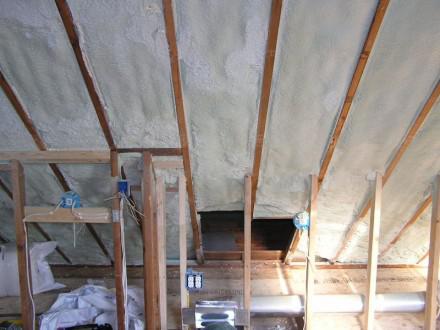While most attic spaces in Minnesota are insulated with fiberglass or cellulose insulation, there is a relatively new product that provides superior performance: spray foam. On old one-and-one-half story houses, foam insulation can be an especially nice way to cut down on heat loss, air leakage, ice dams, yet maintain nearly the same headroom that already exists.
A common way of re-insulating old one-and-one-half story homes in Minnesota is to have closed-cell (2 lb) spray foam applied directly to the roof sheathing, eliminating any ventilation. This type of spray foamed roof is commonly referred to as a 'hot roof'.

Why are they called 'hot roofs?' A traditional attic has an insulated floor and is ventilated. Outdoor air is allowed to come in through the soffits and leave at the top of the roof, creating a cold attic space during the winter. This helps to prevent ice dams, keeps the roof cooler in the summer which may help to prolong the life of the shingles, may help to prevent the accumulation of condensation, and satisfies the warranty requirements of the shingle manufacturer. When spray foam is applied directly to the roof sheathing, there is no longer an unconditioned attic space; the thermal envelope is moved right up against the underside of the roof. Because there is no longer ventilation, these are often called hot roofs.
Are they really hot? No, just slightly warmer. Studies have shown that color differences in shingles will actually have a larger impact on the temperature of shingles than the difference between a ventilated and a spray-foamed roof. A 'hot' roof will typically only be a couple of degrees warmer than a ventilated roof. This has the potential of reducing the shingle life by up to 10%.
What are the benefits? Closed-cell spray foam has a higher insulating value (R-Value) than anything else. Sprayed Polyurethane foam insulation has an R-Value of 6.8 per inch, while fiberglass batt insulation is about half that, and it's nearly impossible to install properly. Foam insulation makes for a perfect seal - no gaps, no air leakage, no attic bypasses. If ductwork is located in the attic space it won't need to be insulated, eliminating a lot of energy loss. Also, on old one-and-one-half story homes with no soffits or very short soffits, adding proper soffit ventilation can be difficult or impossible.
Are hot roofs allowed in Minnesota? This is a tricky question. The current version of the Minnesota State Building Code uses the 2006 International Residential Code, with amendments. If we turn to section R806.4, we find a section titled "Conditioned attic assemblies." This section says "Unvented conditioned attic assemblies (spaces between the ceiling joists of the top story and the roof rafters) are permitted under the following conditions:" ... and then goes on to list a bunch of conditions. So it would seem that hot roofs are allowed, as long as all of the requirements of R806.4 are met.
Not so fast though. One of the Minnesota amendments to the IRC, section 1309.0806, deletes section R806.4 in it's entirety. In other words, this says that hot roofs aren't recognized as an acceptable alternative.
Yeah but still... Minnesota Rules section 1300.0110 Subp. 13 says this:
The code is not intended to prevent the installation of any material or to prohibit any design or method of construction not specifically prescribed by the code, provided that any alternative has been approved. An alternative material, design, or method of construction shall be approved where the building official finds that the proposed design is satisfactory and complies with the intent of the code, and that the material, method, or work offered is, for the purpose intended, at least the equivalent of that prescribed in the code in quality, strength, effectiveness, fire resistance, durability, and safety. The details of any action granting approval of an alternate shall be recorded and entered in the files of the Department of Building Safety.
In other words, if a building official finds that an alternative method of construction is satisfactory and complies with the intent of the code (etc etc), they "shall" approve it. In February of 2011, a letter was written on this topic by Sr. Building Code Representative Donald Sivigny to State Building Officials in Minnesota, offering commentary on code acceptance of unvented attic assemblies. You can read the letter here - http://www.dli.mn.gov/CCLD/PDF/OpinionStaffAttic.pdf .
As mentioned in the letter, the 2012 version of the International Residential Code has expanded the section on unvented attics significantly, and they've also renumbered it as section R806.5. If you're curious about the differences, I put together a pdf showing the two code versions, which can be viewed here 2006 vs 2012 IRC on hot roofs. Keep in mind, the 2012 IRC has not been adopted yet in Minnesota, but I expect section R806.5 won't be deleted in the next wave of Minnesota Building Code changes, which are expected to happen in 2013. It will probably be changed in some fashion, however.
The way it stands now, some cities in Minnesota allow hot roofs as an alternative method of construction and some don't. I contacted the building inspections department in twenty of the largest cities in the Twin Cities area, to ask whether hot roofs, or 'unventilated roofs' were allowed. Here's a breakdown of what some of the different cities had to say about hot roofs. Not all of the cities responded.
No, we don't allow hot roofs.
- Apple Valley
- Delano
- Eagan
- Eden Prairie
- Edina (probably not)
- Hopkins
- Lakeville
- Maple Grove
- Plymouth
- Shakopee
- Saint Louis Park
- Woodbury

